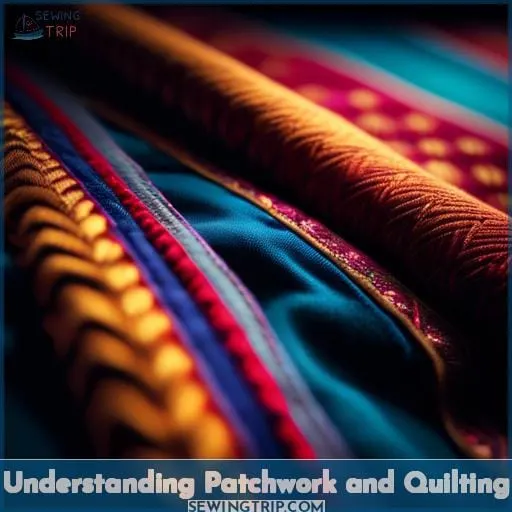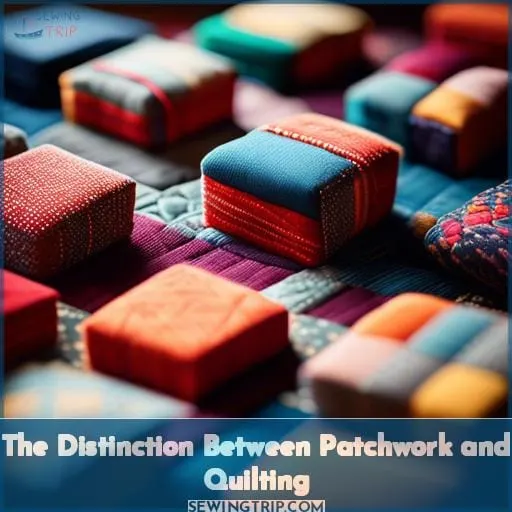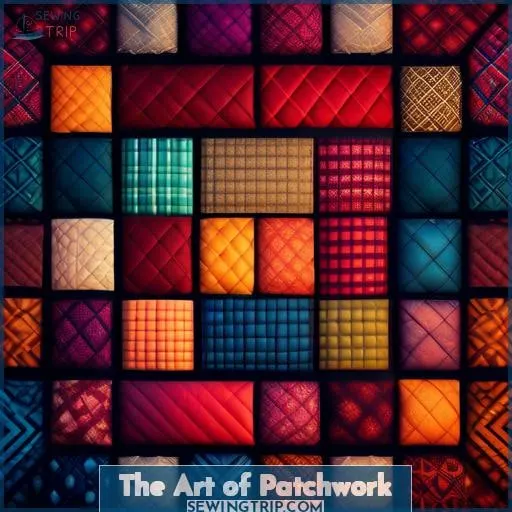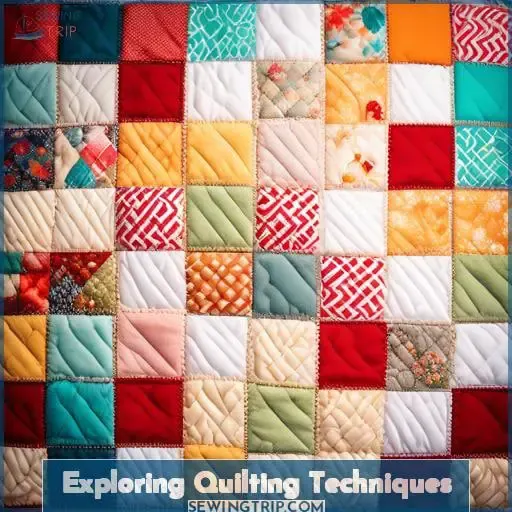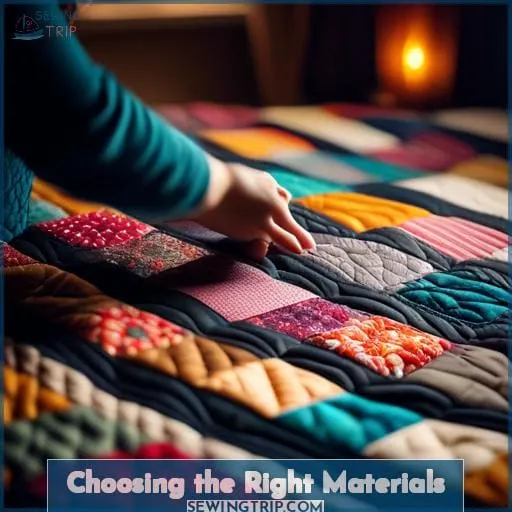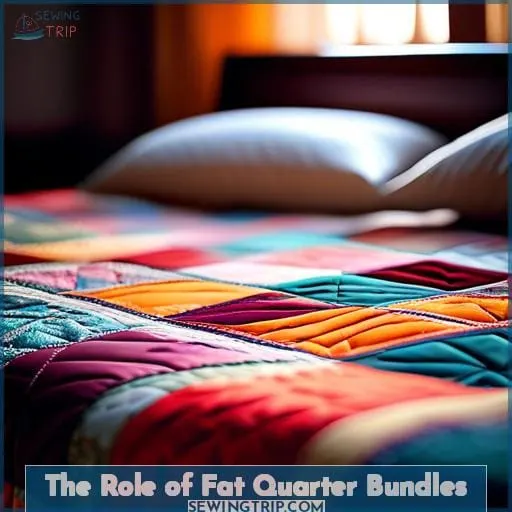This site is supported by our readers. We may earn a commission, at no cost to you, if you purchase through links.
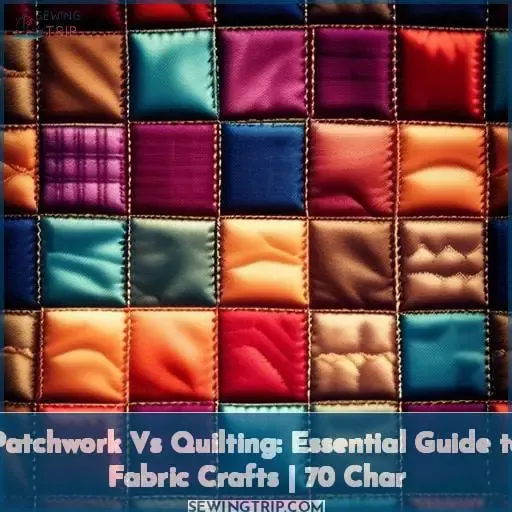 Dive into the captivating world of fabric crafts with our essential guide on Patchwork vs Quilting. You’ll discover not just the beauty but the distinct techniques and purposes behind each craft.
Dive into the captivating world of fabric crafts with our essential guide on Patchwork vs Quilting. You’ll discover not just the beauty but the distinct techniques and purposes behind each craft.
Patchwork, the art of sewing together pieces of fabric to create intricate designs, contrasts with quilting, which involves stitching layers together for warmth and decoration.
Whether you’re aiming to master these skills or simply appreciate the craftsmanship, understanding these differences will enrich your fabric craft journey.
Let’s unravel the unique charm and creativity that patchwork and quilting bring to the table.
Table Of Contents
Key Takeaways
- Patchwork and quilting are distinct processes within quilt making: Patchwork involves sewing together small pieces of fabric to create a larger, visually appealing piece, often used for the quilt top. Quilting, on the other hand, refers to the stitching that combines the quilt top, a layer of batting, and a backing fabric into a cohesive quilt.
- Patchwork focuses on design and geometric shapes: It is the art of assembling small fabric pieces, often geometric, into intricate designs for the quilt top. This process emphasizes creativity and precision in cutting and stitching.
- Quilting adds texture, warmth, and durability: Beyond holding the layers of a quilt together, quilting enhances the quilt’s texture, visual appeal, and comfort. Techniques range from simple stitching around the edges to elaborate free-motion quilting designs.
- Material choices are crucial for both patchwork and quilting: The best fabric for both techniques is 100% cotton, specifically quilter’s weight cotton, due to its softness and durability. Tools like rotary cutters, sharp needles, and quality threads are also important for achieving precision and longevity in quilt making.
Understanding Patchwork and Quilting
You’re about to explore the rich traditions and intricate techniques of patchwork and quilting.
Two fabric crafts that have evolved over time yet remain distinct in their methods and purposes.
Let’s unravel their histories and understand how they’ve become staples in the crafting world.
Definitions and Core Concepts
You’re about to dive into the cozy, colorful world of patchwork and quilting, where every stitch tells a story and every fabric scrap has potential.
Let’s start at the very beginning: patchwork origins trace back to ancient times, with the Egyptians piecing together fabric for clothing and decor. Fast forward to quilting history, and you’ll find a rich tapestry of techniques used for warmth and artistic expression.
Your fabric choices are your palette, and inspiration sources are as boundless as your imagination. Whether you’re following design trends or blazing your own trail, the patterns and techniques you choose will weave your personal narrative into every creation.
So grab your thimble, and let’s stitch a legacy into the quilt of history!
Historical Context and Evolution
Dive into the rich tapestry of patchwork and quilting, where every stitch tells a story of cultural heritage, artistic innovation, and communal bonds.
Historical Origins: Quilting’s roots stretch back to ancient civilizations, with quilted garments for protection and warmth. Patchwork, a testament to thrift and creativity, evolved as a way to repurpose fabric scraps into beautiful designs. These practices weren’t just about utility but also expressed personal and cultural narratives, from the intricate quilted armor of Crusade soldiers to the symbolic quilts guiding slaves to freedom via the Underground Railroad.
Cultural Influences: Across continents, quilting and patchwork reflect the diverse tapestry of human culture. The Amish community’s minimalist quilts, the vibrant patterns of African kanga fabrics, and the meticulous French boutis quilting showcase how these crafts are deeply embedded in cultural identity and heritage.
Technique Evolution and Notable Artists: Over centuries, quilting and patchwork have evolved from hand-stitched essentials to a sophisticated art form. Innovations like the sewing machine transformed quilt-making, enabling more intricate designs and broader creativity. Today, artists like those from Gee’s Bend continue to push boundaries, blending tradition with contemporary themes, and ensuring these crafts remain a dynamic and evolving form of artistic expression.
Embark on your quilt-making journey, and you’ll stitch your way through a rich history of innovation, mastery, and cultural celebration.
The Distinction Between Patchwork and Quilting
When exploring the fabric crafts of patchwork and quilting, it’s crucial to recognize their distinct roles in quilt making.
Patchwork is the art of sewing small fabric pieces into a larger design, often a quilt top.
Quilting refers to the process of stitching together the quilt top, batting, and backing into a finished quilt.
Technique and Purpose
As you dive into the world of fabric crafts, it’s crucial to grasp the distinction between patchwork and quilting. Patchwork is the art of sewing together bits of fabric to create a tapestry of design, a canvas of geometric shapes that tell a story.
It’s like piecing together a puzzle where each fragment is a whisper of history, a snippet of tradition. Quilting, on the other hand, is the act of binding these stories with stitches, layering them with warmth and comfort.
Imagine patchwork as the writer, carefully selecting words—here, fabrics—and quilting as the editor, bringing coherence and structure to the tale. Your fabric choices are your vocabulary, and with artistic experimentation, you can weave modern innovations into this historical evolution.
Whether you’re adding decorative elements through appliqué or exploring new stitching techniques, remember that each quilt is a unique expression of creativity, a testament to the quilter’s journey from simple blocks to intricate masterpieces.
Usage in Quilt Making
In the world of fabric crafts, understanding the usage of patchwork and quilting in quilt making is like piecing together a puzzle with a cozy outcome.
Patchwork Pizzazz: At its core, patchwork is all about assembling those charming geometric shapes into a quilt top. Whether you’re crafting a vibrant quilt, a stylish bag, or adding a touch of personality to your home decor, patchwork sets the stage. It’s where your creativity meets the cutting mat, and those fabric blocks become the canvas for your imagination.
Quilting Quirks: Once your patchwork masterpiece is pieced together, quilting takes the spotlight. This is where you sandwich your quilt top with batting and backing, then stitch them into unity. Quilting isn’t just about binding layers; it’s where texture meets function, transforming your work from a flat piece of art into a warm, tactile treasure.
Material Matters: Choosing the right materials can make or break your project. Fat quarter bundles are your best friends here, offering a variety of coordinated fabrics that are just the right size for both patchwork and quilting. And let’s not forget the essentials: 100% cotton thread for piecing, sharp needles, and that trusty 1/4 quilting foot. With these tools in hand, you’re well on your way to creating something truly special.
The Art of Patchwork
In exploring the art of patchwork, you’ll find that it’s a craft steeped in creativity and precision.
You’ll need the right materials and tools to bring your intricate designs to life. This includes the geometric patterns formed by sewing together small fabric pieces and the selection of quality threads and sharp needles.
Techniques and Patterns
Diving into the art of patchwork, you’re stitching not just fabric, but stories and memories into a canvas of comfort.
| Technique | Description |
|---|---|
| Basic Blocks | Start simple. Squares and triangles are your best friends. Precision is key, so measure twice, cut once! |
| Color Play | Mix and match. Your fabric selection sets the mood. Think of your quilt as a painting made of fabric. |
| Assembly | Sew your pieces together with care. This is where your quilt begins to take shape. Remember, patience is a virtue. |
Patchwork patterns are the heart of your quilt, dictating its rhythm and flow. Whether you’re aiming for a traditional look or experimenting with modern designs, your choice in fabric selection and material choice will set the tone.
From the cozy layers of quilt batting to the final touch of decorative stitching, every step is a stitch closer to creating a masterpiece. So, grab your sewing kit, and let’s turn those shapes and layers into a work of textile art.
Materials and Tools
Continuing from the exploration of patchwork techniques and patterns, let’s dive into the materials and tools that will elevate your quilting game. You’ll want to start with high-quality quilters weight cotton, which is a dream to work with due to its stability and array of designs.
When it comes to piecing those geometric shapes together, precision is key, and a sharp rotary cutter alongside a reliable cutting mat will ensure your blocks are cut to perfection.
Thread quality can’t be overstated; opt for 100% cotton or a strong polyester thread that won’t let you down mid-seam. Needle sizes are also crucial; a size 11 or 12 is sharp enough to handle the layers without creating large holes.
And let’s not forget the sewing machine, your trusty sidekick in this creative journey. With these tools in hand, you’re not just making a quilt; you’re crafting a legacy, one stitch at a time.
Exploring Quilting Techniques
Quilting techniques not only bind the layers of your quilt together but also add both functional and decorative elements to your project.
You’ll find that the stitching involved can transform a simple quilt into a textured, visually appealing masterpiece.
Stitching Layers Together
After piecing together your patchwork with precision, you’re ready to dive into the heart of quilting: stitching layers together. This is where your quilt truly comes to life, as you sandwich the top, batting, and backing into a cozy masterpiece.
Whether you’re a fan of the rhythmic dance of hand quilting or the hum of a machine powering through decorative stitching, each stitch is a step closer to your quilt’s completion.
- Embrace the charm of hand quilting, where every stitch tells a story and connects you to the long lineage of quilters before you.
- Explore machine quilting techniques, from functional quilting that holds your creation together to decorative stitches that add personality and flair.
- Delight in the variety of quilting designs, whether you’re echoing the geometry of your patchwork with squares, adding depth with applique quilting, or playing with the precision of paper piecing quilting.
Decorative and Functional Aspects
Quilting isn’t just about piecing together a cozy bedspread; it’s an art form that turns your fabric stash into decorative textiles and functional quilts. Imagine transforming your home decor inspiration into reality, with every stitch adding a layer of comfort and style.
Whether you’re mastering the cathedral window patchwork or piecing quilting, each project is a chance to organize that fabric stash with flair.
Dive into quilting workshops to finesse your english paper piecing, turning bed coverings into decorative pieces that tell a story. It’s not just about making something to snuggle under; it’s about creating a masterpiece that might just end up as the centerpiece of your living room.
Choosing the Right Materials
When selecting materials for your patchwork and quilting projects, it’s crucial to choose the right fabrics and threads.
Opt for quilter’s cotton, which offers stability and durability, and pair it with quality threads that match your fabric choice.
Your needles and other supplies, like a sharp rotary cutter and precise rulers, will ensure accuracy and ease in your work.
Best Fabrics for Patchwork and Quilting
Choosing the right materials for patchwork and quilting isn’t just about picking pretty patterns; it’s a strategic game of matching fabric selection, thread types, needle sizes, and tools and equipment to your project’s needs.
You’re crafting a legacy, not just a cozy blanket! Think of your fabric stash as a treasure trove, where each piece of quilter’s cotton is a gem for your stained glass patchwork or somerset patchwork masterpiece.
When threading your needle, remember that 100% cotton thread is your trusty sidekick for piecing, while the modern polyester thread can be the unsung hero of durability. Needle sizes are like keys to different doors—choose the right one, and you’ll unlock seamless stitches without a hitch.
Don’t let your tools and equipment gather dust; they’re the silent partners in your dance of domestic economy. And for heaven’s sake, keep your materials organized—there’s nothing worse than a fabric avalanche when you’re on the brink of brilliance.
Remember, the differences between patchwork and quilting are as important as knowing your tango from your foxtrot.
Importance of Thread, Needles, and Other Supplies
Choosing the right thread, needles, and other supplies is like picking the perfect spices for your quilting stew.
Thread selection is your secret sauce; it holds everything together but can snap under pressure if you skimp on quality.
Needle sizes are your finely tuned instruments, with size 11 or 12 being the sharp conductors for your quilting symphony.
Don’t forget, your tool recommendations are the supporting cast—think rotary cutters and mats as the stage crew that sets the scene for your masterpiece.
Fabric preferences are your personal flair, with 100% cotton leading the parade.
Lastly, keep your supply storage as tidy as a pin cushion—each item in its place, ready for action.
Quilting isn’t just a craft; it’s a carefully orchestrated performance where every detail counts.
The Role of Fat Quarter Bundles
You’ve likely encountered fat quarter bundles in your quilting adventures, offering a practical and creative boost to your projects.
These pre-cut pieces aren’t only time-savers but also provide an array of coordinated patterns and colors, perfect for adding variety to your work without the commitment to larger fabric quantities.
Advantages for Patchwork and Quilting Projects
Fat quarter bundles are your secret weapon for patchwork and quilting projects. They’re like a spice rack for your fabric pantry, offering a smorgasbord of coordinated colors and patterns that make your designs pop.
Think of them as the Swiss Army knife in your crafting toolkit; they slice through the hassle of thread selection and fabric weight decisions. With these bundles, you’re the maestro, orchestrating quilting stitches that turn a simple piece into a symphony of texture and style.
Variety and Selection Tips
Continuing from the benefits of fat quarter bundles, let’s dive into the nitty-gritty of fabric selection.
- Color Combinations: Like a painter with a palette, choose bundles that offer a harmonious blend of hues. Think of your quilt as a canvas where each fabric adds a stroke of genius.
- Bundle Variety: Variety is the spice of life—and quilts! Look for bundles that mix patterns and solids, giving you a playground of textures.
- Size Options: Consider the scale of your project. Need tiny tessellations or grand designs? Pick a bundle with sizes that match your vision.
- Project Inspiration: Let the bundle whisper ideas to you. Does it scream cozy cottage or modern chic? Let it guide your next quilting adventure.
Frequently Asked Questions (FAQs)
Can synthetic fabrics be used in patchwork?
You can indeed use synthetic fabrics in patchwork.
Just remember they can be slippery customers!
Stabilize them first to avoid a wrestling match with your sewing machine.
Is hand stitching preferable for quilting?
Ever wondered if your stitches should sing with the rhythm of your hands?
Hand stitching quilting offers a personal touch, creating a connection with each stitch.
It’s not faster, but for many, it’s a labor of love, imbuing warmth into every thread.
How does batting choice affect quilt warmth?
Your quilt’s warmth hinges on the batting you choose, like picking the right filling for a winter coat.
Cotton batting offers a classic, crinkly warmth, perfect for snuggling.
Wool, on the other hand, is your ticket to toasty, offering superior heat without the bulk.
Think of batting as your quilt’s secret ingredient; the right choice turns it from a mere blanket to a cozy haven.
Can quilting be done without a sewing machine?
Absolutely, you can quilt without a sewing machine! Dive into the world of hand quilting, where each stitch adds a personal touch and a dash of coziness.
It’s like cooking from scratch—slower but oh-so satisfying. Grab your needle and thread, and let’s get stitching!
Are there eco-friendly alternatives for quilt batting?
You can indeed go green with your quilting!
Consider using flannel sheets, thrifted blankets, or organic cotton and bamboo blends as eco-friendly batting alternatives.
Keep stitching sustainably!
Conclusion
Harnessing the skills of patchwork and quilting, you’ve journeyed through a world of creativity and warmth.
From the precise piecing of fabrics in patchwork to the cozy layers stitched in quilting, you’ve seen how each technique serves its unique purpose.
As you choose your materials and patterns, let your passion guide you, and may your fabric crafts be as fulfilling as they’re beautiful.
Keep these crafts alive, stitching together not just fabric, but also a legacy of tradition and innovation.

